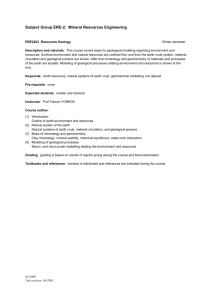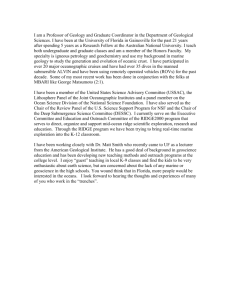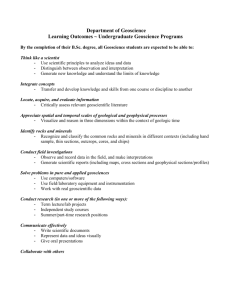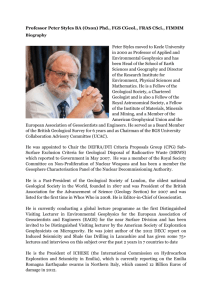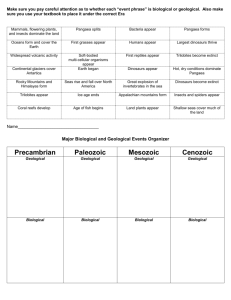G 447
advertisement
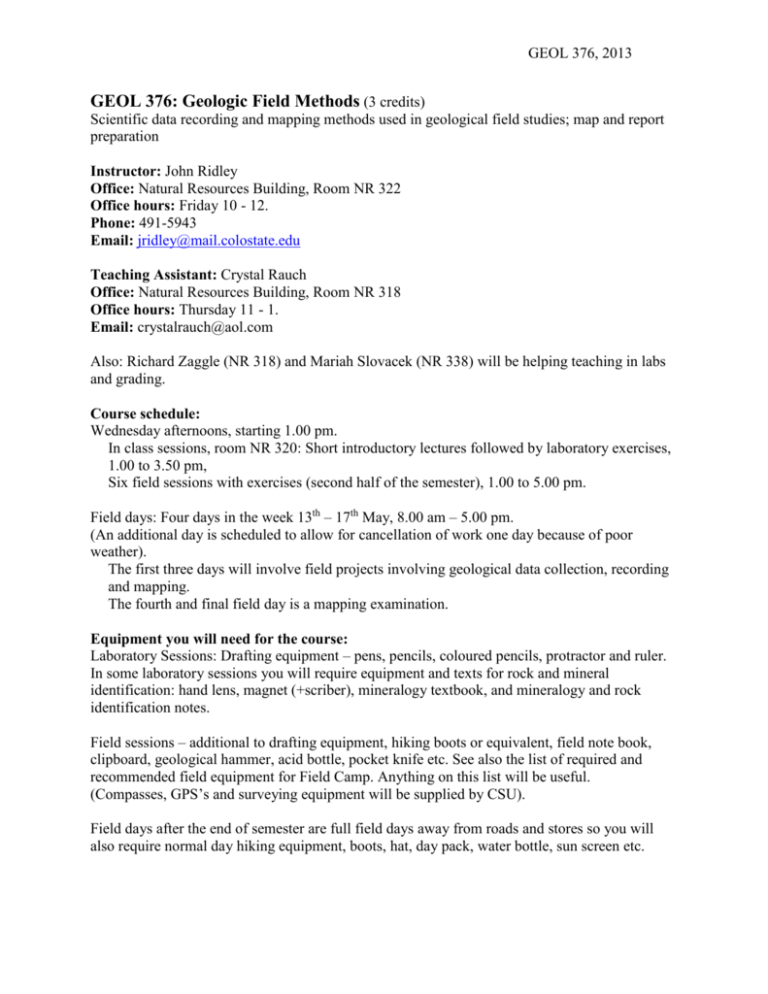
GEOL 376, 2013 GEOL 376: Geologic Field Methods (3 credits) Scientific data recording and mapping methods used in geological field studies; map and report preparation Instructor: John Ridley Office: Natural Resources Building, Room NR 322 Office hours: Friday 10 - 12. Phone: 491-5943 Email: jridley@mail.colostate.edu Teaching Assistant: Crystal Rauch Office: Natural Resources Building, Room NR 318 Office hours: Thursday 11 - 1. Email: crystalrauch@aol.com Also: Richard Zaggle (NR 318) and Mariah Slovacek (NR 338) will be helping teaching in labs and grading. Course schedule: Wednesday afternoons, starting 1.00 pm. In class sessions, room NR 320: Short introductory lectures followed by laboratory exercises, 1.00 to 3.50 pm, Six field sessions with exercises (second half of the semester), 1.00 to 5.00 pm. Field days: Four days in the week 13th – 17th May, 8.00 am – 5.00 pm. (An additional day is scheduled to allow for cancellation of work one day because of poor weather). The first three days will involve field projects involving geological data collection, recording and mapping. The fourth and final field day is a mapping examination. Equipment you will need for the course: Laboratory Sessions: Drafting equipment – pens, pencils, coloured pencils, protractor and ruler. In some laboratory sessions you will require equipment and texts for rock and mineral identification: hand lens, magnet (+scriber), mineralogy textbook, and mineralogy and rock identification notes. Field sessions – additional to drafting equipment, hiking boots or equivalent, field note book, clipboard, geological hammer, acid bottle, pocket knife etc. See also the list of required and recommended field equipment for Field Camp. Anything on this list will be useful. (Compasses, GPS’s and surveying equipment will be supplied by CSU). Field days after the end of semester are full field days away from roads and stores so you will also require normal day hiking equipment, boots, hat, day pack, water bottle, sun screen etc. GEOL 376, 2013 Background of the Course: There are few projects that an Earth Scientist will undertake in a professional career that do not involve at least a component of field work, whether this is producing a map, the collection of data in the field, or the collection of specimens in a spatial and scientific context. This course covers geoscience field skills and the techniques used in mapping and field data collection. It includes exercises involving the use of remote sensing and image interpretation as aids to geological interpretation. The course constitutes preparation for the Geology Summer Field Course GEOL 436. As part of this class, the College Careers Service will present two sessions on writing resumes and job applications. Learning Objectives: Successful students will: (i) Learn and practice techniques of collecting different types of geoscience field data (geological, geophysical, hydro-geological and geomorphological), including techniques of accurate position finding. (ii) Be able to systematically and accurately report and record field data in field notebooks, and on maps. (iii) Be able to interpret geological histories from one’s own field data, including preparation of geological cross sections. (iv) Have a basic knowledge of the types of remotely sensed data and imagery (airphotos, satellite images, geophysical data) that are used to aid geological interpretations and field surveys. (v) Have developed skills for reading and interpreting professionally produced geoscience maps in different geological terrains, including interpretations of geological histories and preparation of complex cross sections. Course assignments and evaluation: 56 % - field and laboratory exercises and projects assigned each week through the semester. These exercises will require independent or group work after class hours to complete. 24 % - day-long field projects after end of semester (13th – 15th May) 20 % - final field mapping exam on the last day of the field sessions (16th or 17th May). The percentage weight of the final exam will be reduced if bad weather makes field work difficult on the day. Course grading: The correlation between letter and numerical grades in this course will be approximately: A ≥ 80 > B ≥ 70 > C ≥ 60 > D ≥ 50 > F. +/- grading will be used. These breakpoints are used because many of the assignments involve argumentation and interpretation where there is no single and straightforward correct answer. GEOL 376, 2013 Geologic Field Methods: Provisional Schedule Date Hours Topic Jan. 23 1-4 Jan. 30 1-4 Feb. 6 1-4 Feb. 13 1-4 Feb. 20 Feb. 27 1-4 1-4 Mar. 6 1-4 Mar. 13 1-4 Mar. 27 1-5 Apr. 3 1-5 Apr. 10 1-5 Apr. 17 1-5 Apr. 24 May 1 1-4 1-5 May 8 1-5 May 20-23 8-5 Introduction: Variety of Geoscience maps; Geoscience map interpretation exercises I On-line databases; Interpretation of geological features visible on National Map; Google Earth (NR GTL Computer Lab.) 1.00 to 3.00pm. 3.00 to 3.50pm. Interpretation of geology Career’s Center workshop; using topography. Resumés and Cover Letters 1.00 to 3.00pm. 3.00 to 3.50pm. Introduction to air photo Career’s Center workshop; interpretation and DEM’s; Air Job interviews photo interpretation projects Air photo interpretation (complete projects) Introduction to remote imaging in geology: radiometrics, thermal imaging; measurement of radioactivity of rocks Remotely sensed image interpretation: aeromagnetics, gravity; measurement of magnetic susceptibility and density of rocks Rock observations: describing field specimens Field observations, recording in field notebooks, measurements of strike and dip using Brunton compasses: Navigation and determination of position using GPS, triangulation (local field site) Field observations, field notebooks (cont.), navigation (cont.), field sketches, (local field site) Mapping, recording and interpretation of surficial and Quaternary sediments and their landforms (Devil’s Backbone) Geophysical survey project (seismic refraction or GPR), total station surveying, finish surficial sediment mapping project (Devil’s Backbone) Geoscience map interpretation exercises II (in lab) Hydrogeological surveying, total station surveying (Gateway, Poudre Canyon) Geological sections and section measuring, using the principles of mappable units, traverses (local field site) Monday to Thursday: Geological mapping of increasing complexity (3 days) and exam (1 day) (each day 8.00 am to ~ 5.00 pm) Guest Instructors KH KH DH SR


